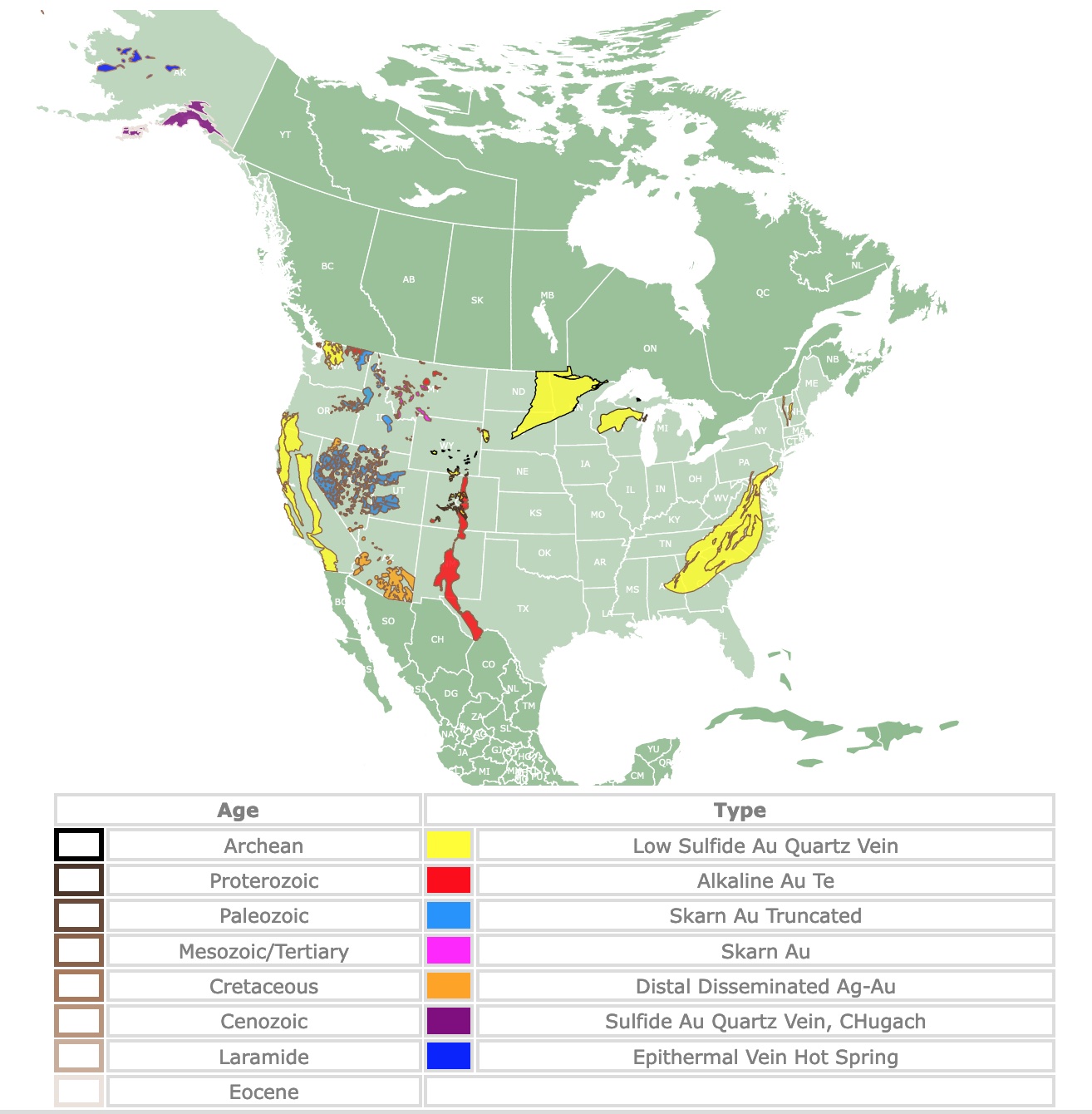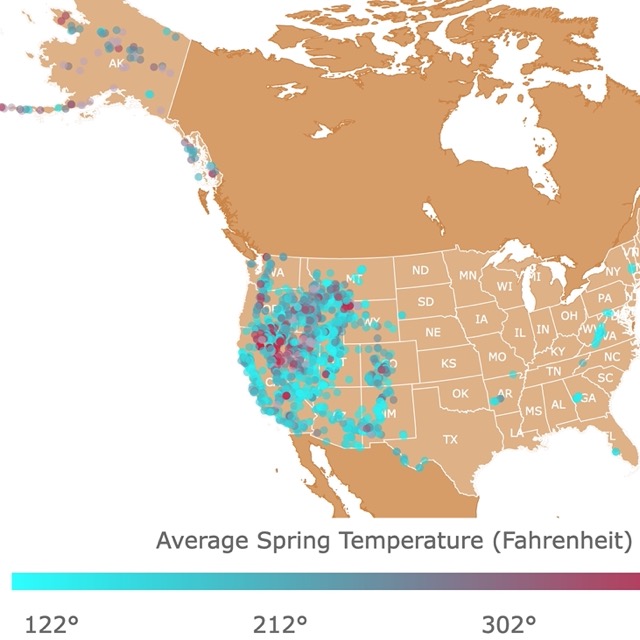Map of Gold Deposits in the U.S.A.
This map shows estimated gold deposits in the U.S.A. Gold-type deposits have different colors. The age of these deposits is represented by different polygon stroke colors. For details, hover over the map. To take a closer look, zoom in. For more information, scroll down.
| Age (One Million years, Ma) | Type | ||
|---|---|---|---|
| Archean (4000 - 2500 Ma) | Low Sulfide Au Quartz Vein | ||
| Proterozoic (2500 - 540 Ma) | Alkaline Au Te | ||
| Paleozoic (540 - 250 Ma) | Skarn Au Truncated | ||
| Mesozoic (250 - 67 Ma) / Tertiary (67 - 2 Ma) | Skarn Au | ||
| Cretaceous (145 - 67 Ma) | Distal Disseminated Ag-Au | ||
| Cenozoic (67 - 0 Ma) | Sulfide Au Quartz Vein, Chugach | ||
| Laramide (~70 - ~35 Ma) | Epithermal Vein Hot Spring | ||
| Eocene (56 - 35 Ma) | |||
Gold
Gold is a dense, soft, unreactive metal with a distinctive yellow color.
Gold is a noncorrosive, durable, unreactive metal. However, it will dissolve in aqua regia (a mixture of nitric and hydrochloric acids).
Because of this, gold is naturally pure and seldom makes compounds in nature.
Nevertheless, gold is commonly alloyed with silver, with minor amounts of platinum, copper, and other metals. The natural gold-silver alloy is called electrum.
Gold also combines to form the mineral ore calaverite (AuTe2).
Gold has no known biological role and is non-toxic.
Gold may be found as nuggets but is most commonly found as tiny specks embedded in rocks.
The chemical symbol of gold Au comes from its Latin name, aurum. Gold is believed to be the first metal element to be identified.
Gold is valuable because it is lustrous, malleable, scarce, and difficult to extract. It is also valuable because of its electrical conductivity, durability, ductility, and beauty.
Gold is so soft that it cannot be used for jewelry in its purest form. It is alloyed with a mixture of metals like silver, copper, platinum, palladium, and zinc to harden the gold.
Pure gold is termed 24 karat; the common alloy used in jewerly is 14 karat, meaning tat it is 58% gold. The alloy may be yellow or white, depending on the elements added.
It is also used for electronics dentistry, medical tools, aerospace, glassmaking, and automotive industries.
Do you want to learn more about this precious metal? Amazon has Gold: The Race for the World's Most Seductive Metal. In this book, acclaimed author Matthew Hart takes you on an unforgettable journey around the world and through history to tell the extraordinary story of how gold became the world’s most precious commodity.
Gold Original Source
Gold is believed to have formed in the collisions of supernovas and neutron stars. This occurred before the solar system was formed.
Gold went to the Earth's core during the planet's formation. It is accessed today thanks to asteroid bombardment.
Molten lava and volcanic eruptions have also brought gold to the surface.
Earthquakes play a major role, as well as shifting faults that decompress and free mineral-rich water. When the water vaporizes, the veins of quartz with gold deposits form on rock surfaces.
It is unclear how much is in the Earth's core and crust or how much was brought by asteroids. Source: Crisscut.
Because of its original source, gold is more common at the edge of tectonic plates.
If you think you need more guidance to understand the topic, Amazon sells Geology: A Complete Introduction (Teach Yourself). Topics covered include the Earth's structure, earthquakes, plate tectonics, volcanoes, igneous intrusions, metamorphism, weathering, erosion, deposition, deformation, physical resources, past life and fossils, the history of the Earth, Solar System geology, and geological fieldwork!
Age Matters in Gold Exploration
Gold may occur as deposits called lodes, or veins, in fractured rock. It may also be dispersed within Earth's crust.
Most lode deposits form when heated fluids circulate through gold-bearing rocks, picking up gold and concentrating it in new locations in the crust. AMNH.
Two significant episodes of geologic activity worldwide resulted in the formation and preservation of gold deposits.
These episodes were characterized by crust and continent formation and occurred 2.7 billion years ago and 1.9 billion years ago.
Ancient gold deposits are found in greenstone belts. These volcanic belts are more than 2.3 billion years old. Although gold deposits continue to form in active volcanic areas.
There are other deposits associated with seafloor volcanism. These occurred 2.7 billion years ago.
Then there is a barren period of years when there are no major gold deposits for no known reason. It is believed there is no gold in these rocks because there was little tectonic activity on Earth.
In rocks younger than 600 million years, several gold-bearing deposits can be found and are most often associated with more recent mountain building and collision events. Geology for Inv.
The map above displays the Laramide Age. This is a time period of mountain building in western North America. It began ~70Ma and ended ~35Ma. The exact duration is still in discussion.
Some gold deposits have a shorter or more precise time period of origin and others the information is not conclusive and the age has a larger time range.
Msozoic and Tertiary are clumped together.
To learn more about gold and how to find it, Amazon has A Guide to Finding Gemstones, Gold, Minerals & Rocks. This book is written for the geoscientist, prospector, and rockhound. First, it focuses on the physical characteristics of gems and minerals. Then, mineral and rock localities are described using the Public Land Survey System and G.P.S. coordinates.
Gold Deposit Location
Gold in the US is typically found in various geological settings, ranging from placer deposits to hard rock deposits.
Placer Gold Deposits
Placer Deposits, or Secondary Gold Deposits, are the easiest and most cost-effective to mine.
They are formed when gold is eroded by weather (temperature, wind, water) over millions of years from its source rocks.
The gold is flushed out of the rock and accumulates with other heavy minerals as fine gold dust or as small grains, the so-called “nuggets”, and is transported by rivers and streams.
Erosion frees gold from other minerals. Because gold is heavy, it sinks and accumulates in stream beds, alluvial deposits, or the ocean. Source: ThoughtCo.
Some of the most productive placer deposits in the US include those found in the Klondike region of Alaska and California's Sierra Nevada rivers.
If you are interested in Placer Gold Amazon, sells Gold Placer Geology: 20th Anniversary Edition (Modern Gold Dredging Book 1). This book will help you learn “gold placer geology” without needing an encyclopedia and dictionary on hand just to understand it. It explains how gold is laid down and what you can do to get some of it for yourself!
Hard Rock Gold Deposits
Hard rock gold deposits, Lode Gold, or Primary Gold Deposits, are usually found in quartz veins and other types of rock formations.
This gold is transported there via hot hydrothermal fluids from the Earth’s core that flow into rock crevices in the Earth’s crust and settle there.
These deposits require more intensive mining methods, such as underground mining. They are often associated with other metals such as copper, silver, and lead.
Mining is only economically viable with concentrations of more than 2.5 grams per tonne. Normally, however, quartz seams only contain a gold concentration of one gram per tonne. Source: Gold Info.
Some of the most productive hard rock gold mines in the US include the Homestake Mine in South Dakota and the Carlin Trend deposits in Nevada.
Secondary Gold Deposits are not far from its Primary Gold Deposit.
Overall, the geology of US gold deposits is diverse and complex, with different types of deposits requiring other mining methods and technologies.
However, the western states of the U.S. continue to be the country's most productive region for gold mining.
Gold Type Deposits
There are many types of gold deposits, including epithermal vein deposits, intrusion-related breccia pipes, mesothermal turbidite, greenstone-hosted deposits, contact deposits (skarns), replacement deposits, disseminated ores, placers, and Archean banded-iron formation deposits.
There are about 11 well-characterized gold deposit types. Arguably more than any other metal. These types may differ with the source or location.
There are also several deposits of uncertain or unknown origin.
Below is an overview of some of the gold types found on the map.
Archean Low-sulfide Au-quartz veins
The Archean deposits share most geologic characteristics with Proterozoic and Phanerozoic low-sulfide Auquartz veins.
These type of gold deposit is most commonly associated with small amounts of disseminated pyrite or pyrrhotite in well-developed quartz veins.
These deposits have a world production of at least 9,900 m.t., and account for the second largest amount of gold production of any significant mineral deposit type after the Witwatersrand-type paleo-conglomerate-hosted deposits of South Africa.
To learn more about this and other deposits worldwide, visit Map of Gold Deposits Worldwide.
Archean deposits are usually younger (20-100 m.y.). USGS.
Skarn
"Skarn Au deposits are a subset of a spectrum of skarn types that are variously copper-, zinc-lead, or iron-rich. Skarns are metallic sulfide and oxide replacement deposits that occur in carbonate host lithologies adjacent to plutonic bodies with metal-bearing hydrothermal systems." Source: Skarn.
Disseminated Gold Deposits
Low-grade, broad deposits of microscopic gold are found in sedimentary rocks with a diagenetic alteration.
Gold Distribution in the USA
The distribution of gold in the US is uneven. Most gold deposits are in Alaska, California, Nevada, Colorado, and Arizona.
Most of the main gold-producing districts are in the mountainous areas of the United States, where folding, faulting, and igneous intrusions have deformed the rocks.
Resources for USA Gold Map
The shapefiles with gold deposit types in North America are from U.S. Geological Survey, 2001, National Mineral Resource Assessment 1998: Circular 1178, U.S. Geological Survey, Reston, Virginia. It can be downloaded from NMRA.
The Shapefiles with countries were downloaded from Natural Earth.
Made by Luz K. Molina with D3.js.








